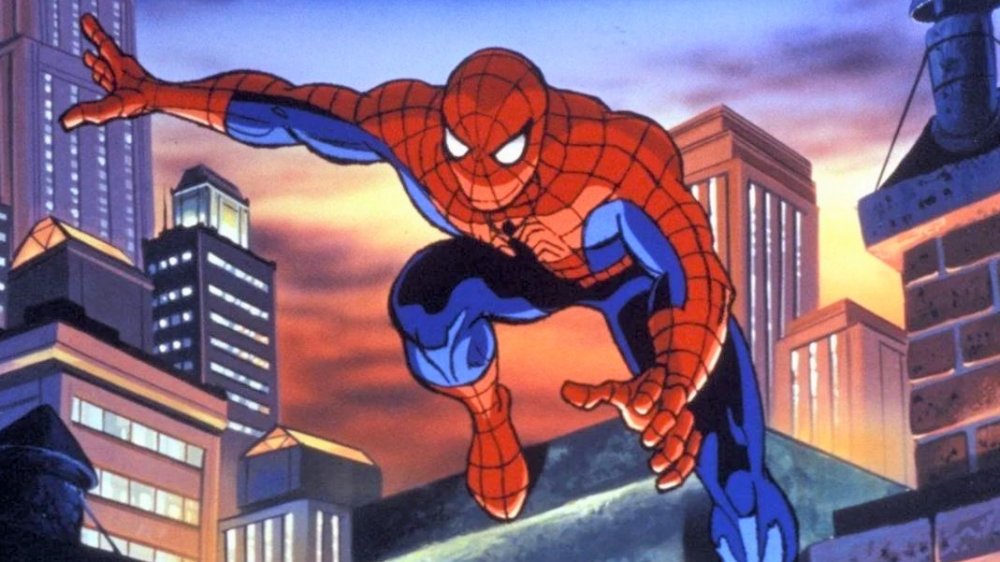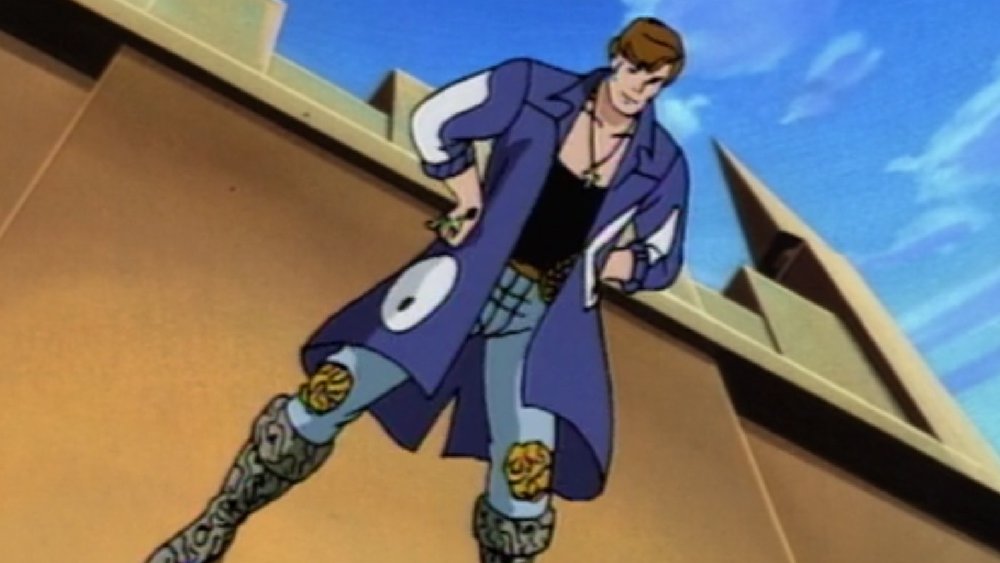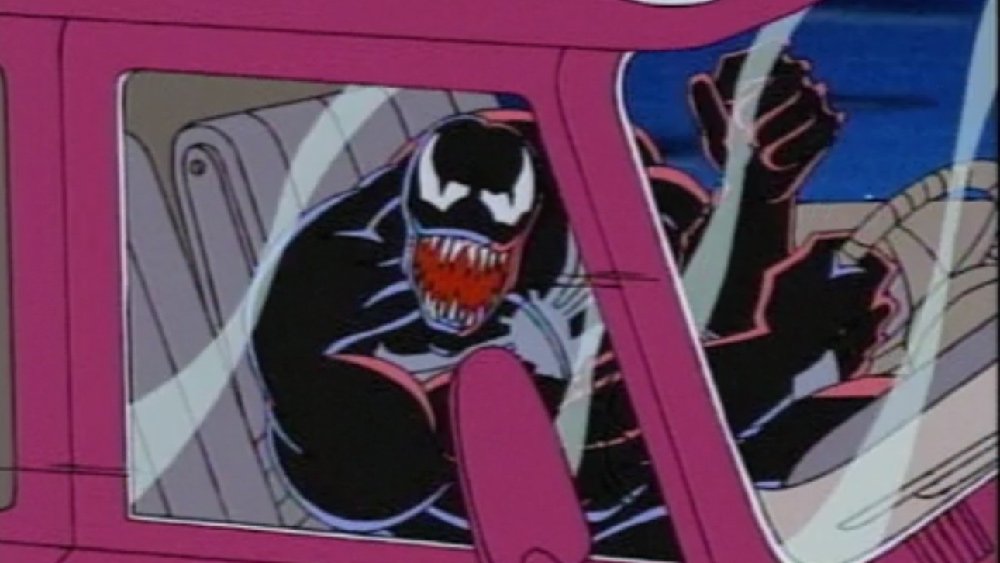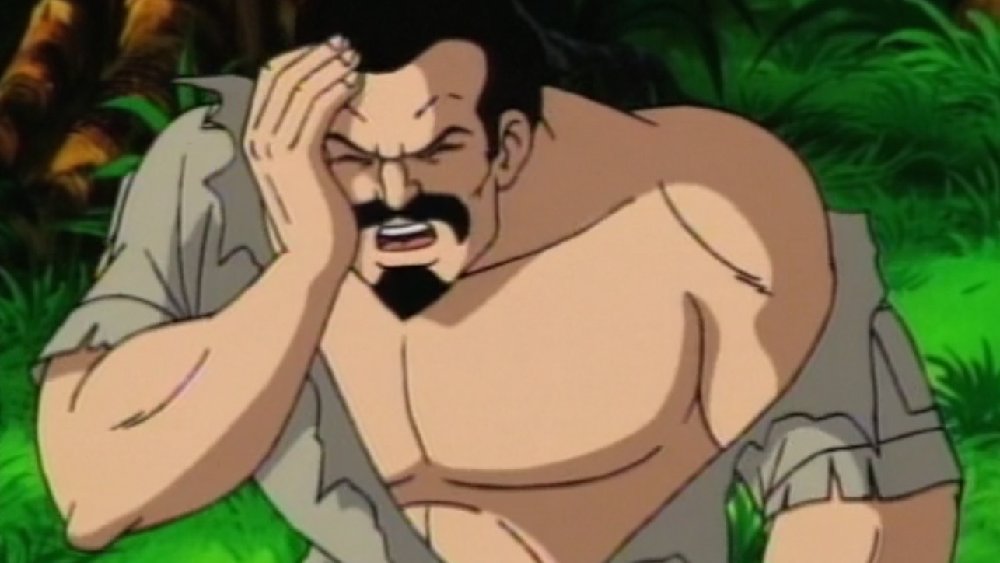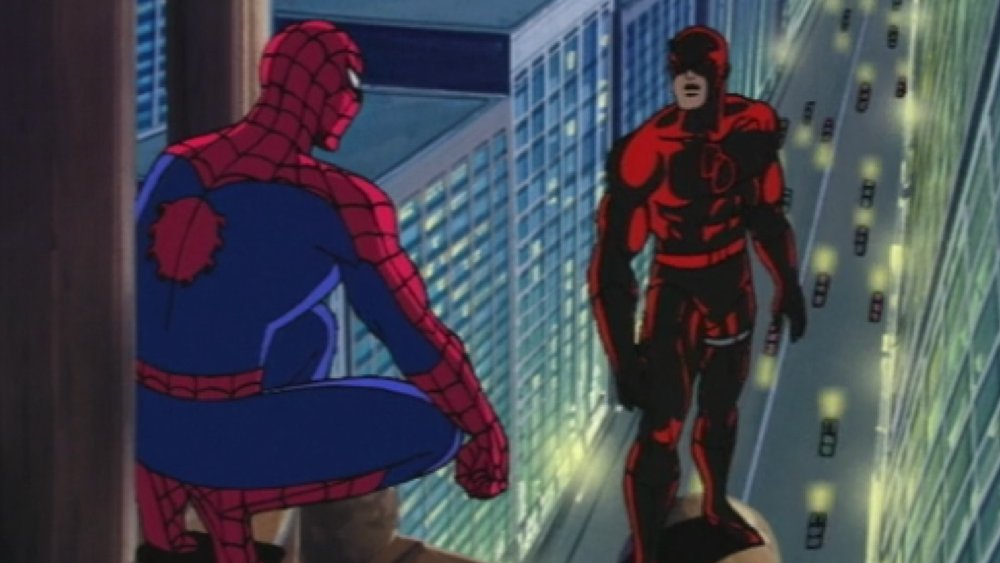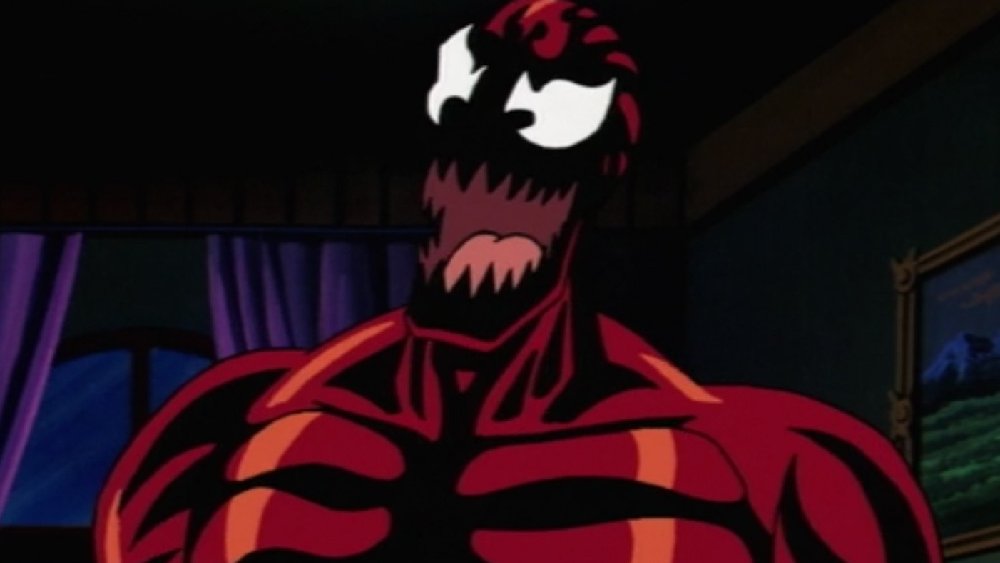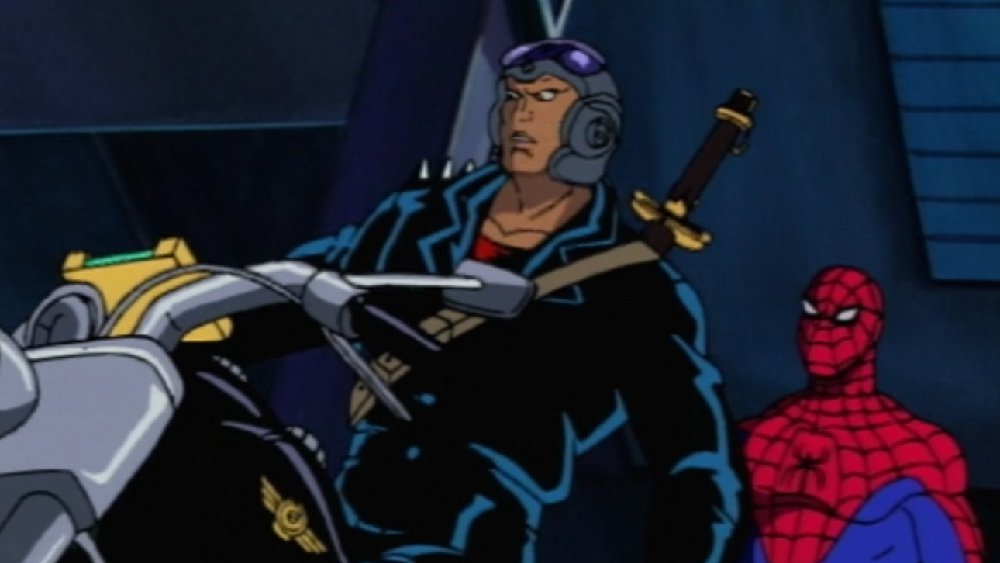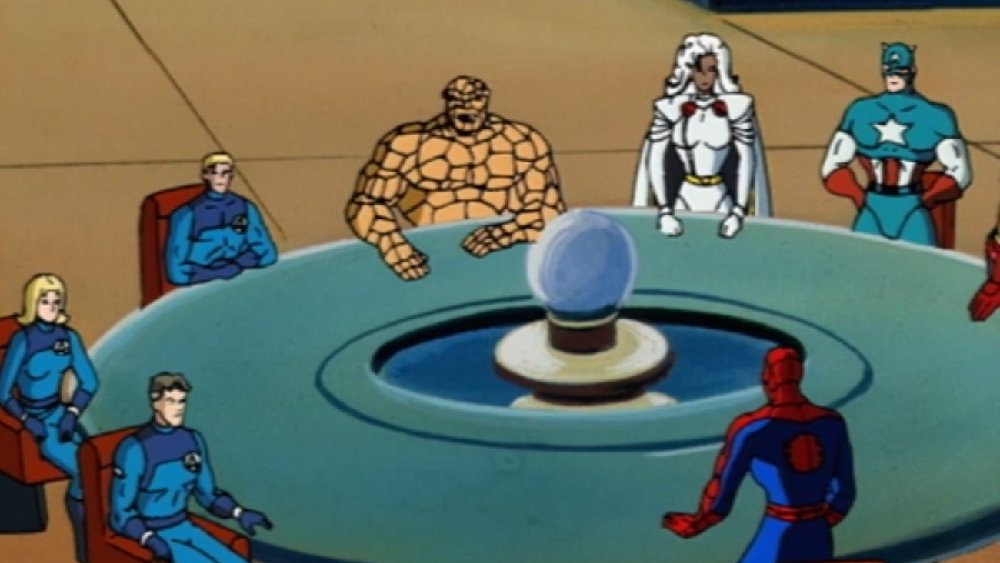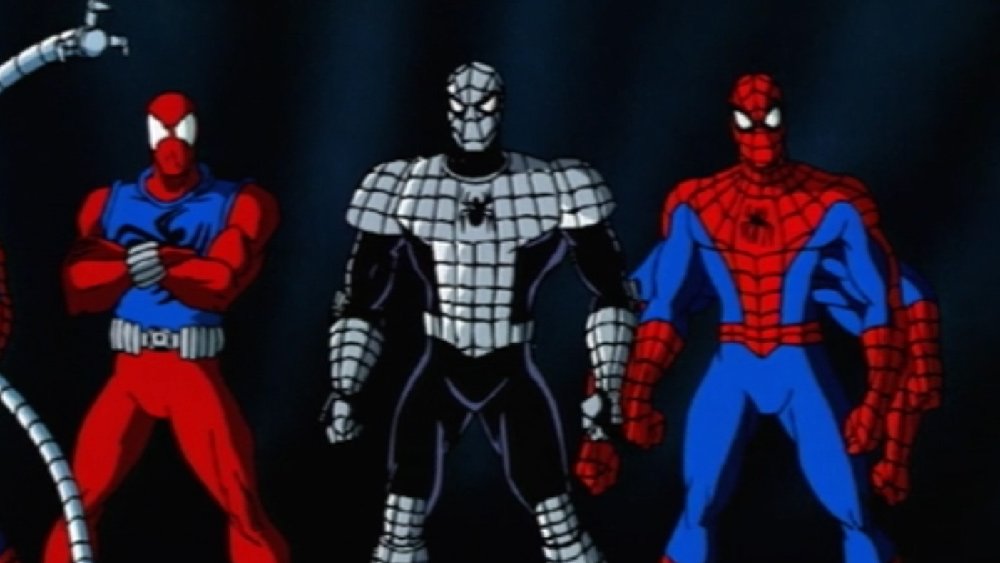The Best Moments From Spider-Man: The Animated Series
Before the record-breaking success of the Marvel Cinematic Universe, before we got 17 years of X-Men movies, and even before Blade declared war on all suck-heads and became the unsung hero that launched Marvel's modern age of movies, we had the animated shows. Led by the massive success that X-Men reached when it hit the airwaves in 1992, the roster of interconnected Marvel cartoons in the '90s would eventually grow to encompass the Fantastic Four, Iron Man, and more, but it rarely got better than it did in 1994, because that's when Spider-Man: The Animated Series debuted.
The web-slinger was no stranger to the world of television. The 1994 show was actually the fourth animated Spider-show, and it was far from being the last. But when it hit the small screen at the height of the '90s comic book boom, it became the definitive version for a whole generation of fans. Now that it's available to stream in its entirety on Disney+, it's well worth a second (or first) viewing, and here are the best moments to watch out for.
Radioactive spider-what?
The opening sequence of Spider-Man isn't remembered as fondly as the title sequence that kicked off every episode of X-Men, and to be completely honest, that's because it's simply not as good. While the merry mutants got all original footage with custom logos where they demonstrated their powers to the tune of the ultimate pump-up guitar riff, Spidey's was mostly made of clips from the show. Sure, one of those clips involved the Punisher whipping a full-on bazooka out of his coat pocket, but still, it was a bit of a letdown.
There was, however, one area where Spidey's opening titles blew everyone else's away: the sheer weirdness. Presumably, producer/songwriter Shuki Levy — whose fingerprints were on almost every pop culture phenomenon of the decade, from Power Rangers to Dragon Ball Z — was trying to go in a different direction than the well-known '60s theme that's still in use in the Marvel movies today. While that song had a peppy chorus about how Spidey does whatever a spider can and ignores wealth and fame, Spider-Man '94 chose to highlight something else about the character in a breakdown that repeated "spider blood, spider blood, radioactive spider blood" through a creepy vocoder. Because really, what gets people more interested than telling them about spider blood and then somehow making it even scarier?
One other interesting note about the theme song? While Levy wrote the tune, it was actually performed by Joe Perry, founding member of Aerosmith and, according to Rolling Stone, the 84th greatest guitarist of all time. Take that, Lindsey Buckingham. There's even a reference to it in the show. When Peter Parker finds himself with an alien costume that can shapeshift into any look he chooses, Peter tests it out by copying the style of "that guy from Aerosmith," with a squealing riff in the background music.
One of the best moments involves Venom and a bad case of road rage
It might surprise you to look back and remember that the show didn't actually use Venom all that often. Of the show's 65 episodes, only four of them feature Eddie Brock and his malevolent outfit as the primary antagonist, and considering that the '90s saw no fewer than 23 Venom series published between 1993 and 1998, that's shockingly restrained. Then again, there's probably only so much you can do with a character who famously eats brains when you've got Broadcast Standards & Practices looking over your shoulder and insisting that the bad guys have to be the "Insidious Six" because "Sinister Six" is a little too scary for the kids.
While they're few in number, though, those four episodes are pretty solid in terms of quality, and they brought some of the show's best moments. Spidey '94 managed to present Venom as both a genuinely creepy threat and a tragic figure, especially when contrasted with his genocidal offspring, Carnage, while also never shying away the inherent goofiness of a big mean Spider-Man that hates the smaller, nicer Spider-Man. It's a tricky balance to walk, but the show pulled it off, and led to a moment that became a full-blown meme.
In Venom's first full appearance, "The Alien Costume, Part 3," he and Spider-Man have a fight on the roof of a subway train. When the train comes up from underground — presumably Peter's using the fight as a shortcut to get back to Queens without having to swipe his MetroCard — Spidey manages to knock Venom off. The fight isn't over yet, though. To keep up the chase, Venom decides that instead of web-swinging, he's going to go full Smokey and the Bandit and steal an 18-wheeler, giving us the delightfully bizarre image of Venom, in full costume, road-raging at Spider-Man. Who knew that one of the alien costume's super powers was the ability to drive stick?
Spider-Man: The Animated Series vs. BS&P
If you're a fan of animation — particularly the cartoons for kids from back in the '90s before the new wave of offbeat shows with a little more freedom to get weird, like Adventure Time or She-Ra and the Princesses of Power — then you might already be familiar with Broadcast Standards & Practices. If you're not, well, BS&P, also known as just "Standards & Practices," is the department of a television network that determines what sort of content can get on the air and what needs to be censored.
Virtually every network show has gotten notes from them about something, but they were a particular headache for the producers of animated shows in the '90s, because when dealing with kids' television, BS&P was notoriously wary of anything more violent than, say, The Smurfs. And while some shows, like Batman: The Animated Series, got away with a little more than the average cartoon, Spider-Man and X-Men found the heavy hand of BS&P coming down pretty hard. You might notice, for instance, that Wolverine never actually uses his claws on anything other than inanimate objects in that show, and you'd be hard pressed to find a single drop of blood anywhere in Spider-Man. While it was probably annoying to write around, however, BS&P's strict regulations did provide the show with some of its most bizarrely enjoyable moments.
Take, for instance, the origin story for Kraven the Hunter. In the comics, Sergei Kravinoff is just a dude who's really into hunting and decides he needs to kill Spider-Man because he's the deadliest of all prey. (Weirdly, he wouldn't figure out that he lived in a world with multiple Godzillas until about 2016.) On the show, however, Kraven was driven to his maniacal man-hunting after his mind was altered by a strange serum that was used to save his life after he got into a fistfight with a bunch of hyenas. The thing is, since Spider-Man couldn't show blood or violence, the life-threatening injuries that Kraven suffered were represented by a torn shirt and Kraven slowly falling over while holding his head like he had a slight migraine.
The team-ups in Spider-Man: The Animated series are awesome
One of the single best things about Spider-Man is that he's quite possibly the easiest character on Marvel's entire roster to throw into a team-up story. He makes a great foil for virtually any other hero, and his perfect mid-range level of super-powers — he's strong but not Hulk strong, smart but not Reed Richards smart — means he can hang with the big guns without overshadowing street-level heroes. There's a reason he was the star of 150 issues of Marvel Team-Up and tends to be the first character to guest star in a brand new superhero title.
The show embraced this aspect of Spider-Man, and long before the Marvel Cinematic Universe hit the big screen, Spider-Man '94 was throwing virtually anyone it could've onto the show, which had the not coincidental side effect of giving the action figure line more characters. There were, of course, the obvious Spidey-adjacent characters like Daredevil and the Punisher, and since the X-Men had their own wildly successful show on the same network, the two-part crossover with them was an easy sell. The show didn't stop there, though. There were guest appearances with Nick Fury, Iron Man and War Machine, Doctor Strange, and even Blade, three years before Wesley Snipes made him a household name.
Sure, those guest appearances aren't without their problems. The Punisher can't kill anyone on a kid's cartoon, so he never actually gets around to punishing anyone with his usual lethal force, and he also has an oddly prominent Chicago accent. Morbius the Living Vampire can't actually drink anyone's blood, so he has weird leech mouths on his hands that he uses to sort of nebulously absorb "plasma." Blade doesn't actually have a blade. Instead, he has a laser sword but still keeps his original name, which is a shame because "Laser" is the only name that's exactly as cool as "Blade." Still, getting to see Spidey teaming up with some of Marvel's coolest characters is definitely a highlight of the series.
One of the best moments involves Carnage's complicated backstory
One of the more interesting things about the superhero cartoons of the early '90s is seeing how they each approached their source material. Batman: The Animated Series stripped things down in terms of both story and art, forsaking complex continuity for an episodic, back-to-basics approach. Spider-Man and X-Men, on the other hand, found success by going in the opposite direction, with most of their episodes spent on faithfully recreating comic book stories in all their overly complicated glory. And when they did deviate from the source material, they deviated hard, and the results could sometimes be glorious.
Want an example? Head to "Venom Returns" and "Carnage," a two-parter that introduces serial killer and symbiote supervillain Cletus Kasady, better known as Carnage, to the show. In the comics, Carnage's introduction is pretty straightforward, as far as stories about symbiotic living costumes from space are concerned. He's a serial killer who gets locked up with Eddie Brock after he's arrested for his many Venom-related crimes. When the Venom symbiote shows up for a jailbreak, it leaves behind its offspring, which bonds with Kasaday and amplifies his homicidal tendencies, giving him the ability to carry out his murderous whims on a much grander scale.
You might think that the show's changes would be limited to being a little more vague about Kasaday's murderous inclinations, and they are, but that's not where they stop. Instead, they spice things up by getting Dormammu, the Dread Lord of the Dark Dimension, who you might remember as the 100 foot-tall monster made of eldritch flames who showed up at the end of Doctor Strange. Dormammu, whose plans usually involve the conquest of entire dimensions, was the mastermind behind Carnage's creation for reasons that are nebulous at best. Through his acolyte Baron Mordo, he delivers Venom's offspring to Kasaday, replacing Eddie Brock after Brock decides that working with a devil the size of a skyscraper is probably not a good idea. It's ridiculously complicated, but throwing in that mystical weirdness makes the whole thing seem even more overwhelming, and Spider-Man stories are at their best when our hero is totally overmatched. Plus, for some reason, War Machine is also there, voiced by James "Uncle Phil" Avery. It rules.
Spider-Man: The Animated Series features a whole lot of vampires
When you think about Spider-Man, vampires aren't exactly the first thing that comes to mind. Sure, there are enough of them running around the Marvel Universe that he has to run into one every now and then, but for the most part, the deepest Spider-Man gets into the Dungeons & Dragons Monster Manual is all the goblins, and even then, it's mostly just guys in costumes. It's pretty surprising, then, to go back and realize how much of the show's '90s run was devoted to vampires and vampire-adjacent content.
Surprising ... and also pretty awesome. While the fiendish bloodsuckers never actually bothered to suck any blood, they did provide the show with some of its best and most unexpected adventures. It's always a dicey proposition for the main character of a superhero show to take a back seat while a guest star steps into the spotlight, but "The Vampire Queen" pulls it off without ever slowing down.
The single episode comes in the middle of a whole series of offbeat team-ups, and along with our title character, it features Blade, the Black Cat, Morbius, the Kingpin, and, of course, the Queen of the Vampires. Even better? In the grandest tradition of soap operatic superhero drama, the Queen of the Vampires turns out to be Blade's long-lost mother. A similar plot would later play out in the Blade movie, although that version replaced the Black Cat and Kingpin with blood raves and cussing. Still, it's absolutely worth going back to, both because it's awesome in its own right and because of how weird it is to see Blade before, well, Blade.
The Secret Wars are pretty epic
Considering that Spider-Man has been Marvel's flagship character since he debuted in the '60s, it's probably not surprising that his show managed to outlast the Iron Man, Fantastic Four, and even the X-Men cartoons. In its last season, though, Spider-Man managed to give that animated universe a pretty amazing send-off in the form of its three-part "Secret Wars" saga.
Loosely based on the 1984 comic book of the same name, "Secret Wars" saw Spider-Man as the subject of an almost Job-like wager between Madame Web, a spider-themed psychic weirdo who wouldn't stop meddling in Peter's life, and an omnipotent being called the Beyonder. In order to determine whether good or evil was stronger, they abducted Spider-Man and dropped him onto a strange planet to battle a bunch of supervillains. With a roster of opponents that included Dr. Octopus, Dr. Doom, the Red Skull, Alistair Smythe, and noted boy-eater Curt Connors, aka the Lizard, Spider-Man had to form a team of his own. To that end, he chose Iron Man, Captain America, Storm, and the Fantastic Four, because, as he pondered out loud while making is decision, "Who's fought that Doctor Doom guy before?"
Looking back from a time when everyone in the world has seen a fight scene between 40 superheroes and an army of monsters led by Thanos, and where formerly obscure characters like Squirrel Girl have been featured in starring roles on cartoons, 'Secret Wars" probably seems quaint. Back in the day, though, getting to see all of your faves — well, most of your faves, Wolverine must've been busy in another crossover that week — was mind-blowing, and for all its goofy dialogue, it still has its charm. If you're going to watch one piece of Spider-Man and want to see something that captures all the thrills and excitement that made the show a hit — and also features Spider-Man carrying Captain America around like a li'l baby — "Secret Wars" is the thing to watch.
Spider-Verse '94
If you're even slightly aware of Spider-Man's comic book adventures, then you know why fans get nervous whenever they encounter the subject of clones. They've caused no end of trouble in the past, not just for Spider-Man, but for the fans who've had to sit through seemingly endless years of the comics' long-running, thoroughly exhausting Clone Saga. That was the story that dominated the Spider-Man books in the mid-'90s, with one clone that framed Spider-Man for murder (Kaine, who used his spider-powers to burn people's faces off), another clone that took over the comics for a year after discovering he was the real Peter Parker, and with the guy we'd been reading about for three decades turning out to actually be the clone (Ben Reilly), as well as a handful of others. It's the Spider-Man story that pretty much everyone agrees on as something that went on way too long — including the people who made it.
With that in mind, you might be understandably leery of "Spider-Wars," the two part series finale of Spider-Man '94, especially since the first episode is literally called "I Really, Really Hate Clones." The thing is, this story is actually great, and it feels less like the original Clone Saga and more like a prototype '90s version of Spider-Man: Into the Spider-Verse. It doesn't quite hit those high points — and since Spider-Verse is arguably the greatest comic book movie of all time, we probably shouldn't expect it to — but it definitely sends the show out on a high note.
This story finds Spider-Man in an alternate universe where Peter Parker bonded with the Carnage symbiote and destroyed Manhattan before following it up by detonating a dimensional bomb that disintegrated the whole space-time continuum. The only way to stop all this from happening is a time-traveling team-up with — and stop us if this sounds familiar — a handful of Spider-Men from alternate dimensions. It is, of course, exactly as goofy as the rest of the show, especially a scene where Good Spidey and Bad Spidey give a giant robot designed to respond to Peter Parker's voice conflicting commands until it explodes. The ending, though, comes with a clever resolution that hits pretty hard and follows it up with the show's perfect ending. Plus, unlike the comics, this Clone Saga only takes 44 minutes to get through.
